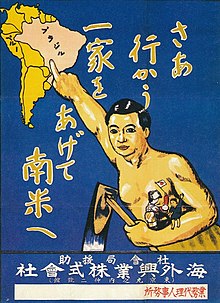Emigration
Emigration is the act of leaving a resident country or place of residence[1] with the intent to settle elsewhere (to permanently leave a country).[2] Conversely, immigration describes the movement of people into one country from another (to permanently move to a country).[3] A migrant emigrates from their old country, and immigrates to their new country. Thus, both emigration and immigration describe migration, but from different countries' perspectives.

Demographers examine push and pull factors for people to be pushed out of one place and attracted to another. There can be a desire to escape negative circumstances such as shortages of land or jobs, or unfair treatment. People can be pulled to the opportunities available elsewhere. Fleeing from oppressive conditions, being a refugee and seeking asylum to get refugee status in a foreign country, may lead to permanent emigration.
Forced displacement refers to groups that are forced to abandon their native country, such as by enforced population transfer or the threat of ethnic cleansing. Refugees and asylum seekers in this sense are the most marginalized extreme cases of migration,[4] facing multiple hurdles in their journey and efforts to integrate into the new settings.[5] Scholars in this sense have called for cross-sector engagement from businesses, non-governmental organizations, educational institutions, and other stakeholders within the receiving communities.[6][7]
History
[edit]Patterns of emigration have been shaped by numerous economic, social, and political changes throughout the world in the last few hundred years. For instance, millions of individuals fled poverty, violence, and political turmoil in Europe to settle in the Americas and Oceania during the 18th, 19th, and 20th centuries. Likewise, millions left South China in the Chinese diaspora during the 19th and early 20th centuries.

"Push" and "pull" factors
[edit]Demographers distinguish factors at the origin that push people out, versus those at the destination that pull them in.[8] Motives to migrate can be either incentives attracting people away, known as pull factors, or circumstances encouraging a person to leave. Diversity of push and pull factors inform management scholarship in their efforts to understand migrant movement.[9][4]
Push factors
[edit]- Poor living conditions or overcrowding
- Lack of employment or entrepreneurial opportunities
- Lack of educational opportunities
- Threat of arrest or punishment
- Persecution or intolerance based on race, religion, gender or sexual orientation
- Political corruption, lack of government transparency or freedom of speech
- Inability to find a spouse for marriage
- Lack of freedom to choose religion, or to choose no religion
- Resource depletion, scarcity or austerity
- Military draft, warfare or terrorism
- Expulsion by armed force or coercion
- Recession or economic collapse
- Famine or drought
- Cultural fights with other cultural groups
Pull factors
[edit]- Higher quality of life, economic growth or lower cost of living
- Encouragement to join relatives or fellow countrymen; chain migration
- Quick wealth (as in a gold rush)
- More job opportunities or promise of higher pay
- Prosperity or economic surplus
- Educational opportunity (including university for adults or K-12 for children)
- Prepaid travel (as from relatives)
- Building a new nation (historically)
- Building specific cultural or religious communities
- Political freedom
- Cultural opportunities
- Greater opportunity to find a spouse
- Favorable climate
- Ease of crossing boundaries
- Reduced tariff
Criticism
[edit]Some scholars criticize the "push-pull" approach to understanding international migration.[10] Regarding lists of positive or negative factors about a place, Jose C. Moya writes "one could easily compile similar lists for periods and places where no migration took place."[11]
Emigration waves by country
[edit]Search for "Emigration from" in titles
- Jews escaping from German-occupied Europe
- Yerida (Jewish emigration from Israel)
- Swedish emigration to the United States
Statistics
[edit]Unlike immigration, in many countries few if any records have been recorded[a] or maintained in regard to persons leaving a country either on a temporary or permanent basis. Therefore, estimates on emigration must be derived from secondary sources such as immigration records of the receiving country or records from other administrative agencies.[14]
The rate of emigration has continued to grow, reaching 280 million in 2017.[15]
In Armenia, for example, the migration is calculated by counting people arriving or leaving the country via airplane, train, railway or other means of transportation. Here, the emigration index is high: 1.5% of population leaves the country annually.[16] In fact, it is one of the countries, where emigration has become a part of culture since 20th century. For example, between 1990 and 2005 approximately 700,000–1,300,000 Armenians left the country. The highly rising numbers of emigration are a direct response to socio-political and economic areas of the country. The internal migration (migration in country) is big (28.7%), while international migration is 71.3% of the total migration by people aging 15 and above. It is important to understand the reasons for both types of migration and the availability of the options. For example, in Armenia, everything is localized in the capital city Yerevan, thus, internal migration is from the villages and small cities to the biggest city of the country. The reason for the migration can be work or study. International migration follows the same reasoning of migration: work or study. The main destinations for it are Russia, France and US.[17]
Emigration restrictions
[edit]
Some countries restrict the ability of their citizens to emigrate to other countries. After 1668, the Qing Emperor banned Han Chinese migration to Manchuria. In 1681, the emperor ordered construction of the Willow Palisade, a barrier beyond which the Chinese were prohibited from encroaching on Manchu and Mongol lands.[18]
The Soviet Socialist Republics of the later Soviet Union began such restrictions in 1918, with laws and borders tightening until even illegal emigration was nearly impossible by 1928.[19] To strengthen this, they set up internal passport controls and individual city Propiska ("place of residence") permits, along with internal freedom of movement restrictions often called the 101st kilometre, rules which greatly restricted mobility within even small areas.[20]
At the end of World War II in 1945, the Soviet Union occupied several Central European countries, together called the Eastern Bloc, with the majority of those living in the newly acquired areas aspiring to independence and wanted the Soviets to leave.[21] Before 1950, over 15 million people emigrated from the Soviet-occupied eastern European countries and immigrated into the west in the five years immediately following World War II.[22] By the early 1950s, the Soviet approach to controlling national movement was emulated by most of the rest of the Eastern Bloc.[23] Restrictions implemented in the Eastern Bloc stopped most east–west migration, with only 13.3 million migrations westward between 1950 and 1990.[24] However, hundreds of thousands of East Germans annually immigrated to West Germany through a "loophole" in the system that existed between East and West Berlin, where the four occupying World War II powers governed movement.[25] The emigration resulted in massive "brain drain" from East Germany to West Germany of younger educated professionals, such that nearly 20% of East Germany's population had migrated to West Germany by 1961.[26] In 1961, East Germany erected a barbed-wire barrier that would eventually be expanded through construction into the Berlin Wall, effectively closing the loophole.[27] In 1989, the Berlin Wall fell, followed by German reunification and within two years the dissolution of the Soviet Union.
By the early 1950s, the Soviet approach to controlling international movement was also emulated by China, Mongolia, and North Korea.[23] North Korea still tightly restricts emigration, and maintains one of the strictest emigration bans in the world,[28] although some North Koreans still manage to illegally emigrate to China.[29] Other countries with tight emigration restrictions at one time or another included Angola, Egypt,[30] Ethiopia, Mozambique, Somalia, Afghanistan, Burma, Democratic Kampuchea (Cambodia from 1975 to 1979), Laos, North Vietnam, Iraq, South Yemen and Cuba.[31]
See also
[edit]- Canvas ceiling
- Deportation
- Diaspora
- Eastern Bloc emigration and defection
- Émigré
- Exile
- Expatriate
- Feminization of migration
- Immigration
- Foot voting
- Human capital flight
- Human migration
- Settlement
- International Organization for Migration
- Migration Letters
- Political asylum
- Political migration
- Population transfer
- Refugee
- RMS Mooltan
- Separation barrier
- Snowbird (people)
- Xenophobia
Notes
[edit]References
[edit]- ^ "emigrate". Miriam-Webster Dictionary. Archived from the original on 2017-08-18.
- ^ "Emigration". Oxford Dictionary. Archived from the original on 2014-11-29.
- ^ "Immigration". Oxford Dictionary. Archived from the original on 2016-05-18.
- ^ a b Szkudlarek, Betina; Nardon, Luciara; Osland, Joyce S.; Adler, Nancy J.; Lee, Eun Su (August 2021). "When Context Matters: What Happens to International Theory When Researchers Study Refugees". Academy of Management Perspectives. 35 (3): 461–484. doi:10.5465/amp.2018.0150. ISSN 1558-9080.
- ^ Lee, Eun Su; Szkudlarek, Betina; Nguyen, Duc Cuong; Nardon, Luciara (April 2020). "Unveiling the Canvas Ceiling : A Multidisciplinary Literature Review of Refugee Employment and Workforce Integration". International Journal of Management Reviews. 22 (2): 193–216. doi:10.1111/ijmr.12222. ISSN 1460-8545. S2CID 216204168.
- ^ Lee, Eun Su; Szkudlarek, Betina (2021-04-14). "Refugee employment support: The HRM–CSR nexus and stakeholder co-dependency". Human Resource Management Journal. 31 (4): 1748–8583.12352. doi:10.1111/1748-8583.12352. ISSN 0954-5395. S2CID 234855263.
- ^ Lee, Eun Su; Roy, Priya A.; Szkudlarek, Betina (2021-08-16), Chavan, Meena; Taksa, Lucy (eds.), "Integrating Refugees Into the Workplace – A Collaborative Approach", Intercultural Management in Practice, Emerald Publishing Limited, pp. 121–129, doi:10.1108/978-1-83982-826-320211011, ISBN 978-1-83982-827-0, S2CID 238706123, retrieved 2021-09-27
- ^ Zeev Ben-Sira (1997). Immigration, Stress, and Readjustment. Greenwood. pp. 7–10. ISBN 9780275956325.
- ^ Lee, Eun Su; Nguyen, Duc Cuong; Szkudlarek, Betina (2020), "Global Migration and Cross-Cultural Management: Understanding the Past, Moving Towards the Future", The SAGE Handbook of Contemporary Cross-Cultural Management, London: SAGE Publications Ltd, pp. 408–423, doi:10.4135/9781529714340.n30, ISBN 978-1-5264-4132-4, S2CID 226552956, retrieved 2021-09-27
- ^ Castles, Stephen (2014). The age of migration : international population movements in the modern world. Palgrave Macmillan. pp. 20–48. ISBN 9780230355767. OCLC 915478576.
- ^ Moya, J. C. (1998). Cousins and strangers. Spanish immigrants in Buenos Aires, 1850–1930. Berkeley, University of California Press. p.14
- ^ "Absentee Voting Information for U.S. Citizens Abroad". travel.state.gov. Retrieved 2021-12-24.
- ^ "U.S. Citizens and Resident Aliens Abroad | Internal Revenue Service". www.irs.gov. Retrieved 2021-12-24.
- ^ Population and Family Estimation Methods at Statistics Canada (PDF). Statistics Canada Demography Division. March 2012. ISBN 978-1-100-19900-9. Archived (PDF) from the original on 2017-08-23.
- ^ "International Migration Report 2017" (PDF). United Nations. 2017. Archived from the original (PDF) on 23 December 2017. Retrieved 4 June 2019.
- ^ Barsoumian, Nanore (2013-01-22). "To Greener Shores: A Detailed Report on Emigration from Armenia". The Armenian Weekly. Retrieved 2021-04-24.
- ^ "Migrant support measures from an employment and skills perspective (MISMES)" (PDF). Working Together Learning for Life. Archived from the original (PDF) on 2021-04-29. Retrieved 2021-04-29.
- ^ Elliott, Mark C. "The Limits of Tartary: Manchuria in Imperial and National Geographies." Journal of Asian Studies 59, no. 3 (2000): 603–46.
- ^ Dowty 1987, p. 69
- ^ Dowty 1987, p. 70
- ^ Thackeray 2004, p. 188
- ^ Böcker 1998, p. 207
- ^ a b Dowty 1987, p. 114
- ^ Böcker 1998, p. 209
- ^ Harrison 2003, p. 99
- ^ Dowty 1987, p. 122
- ^ Pearson 1998, p. 75
- ^ Dowty 1987, p. 208
- ^ Kleinschmidt, Harald, Migration, Regional Integration and Human Security: The Formation and Maintenance of Transnational Spaces, Ashgate Publishing, Ltd., 2006,ISBN 0-7546-4646-7, page 110
- ^ Tsourapas, Gerasimos (2016). "Nasser's Educators and Agitators across al-Watan al-'Arabi: Tracing the Foreign Policy Importance of Egyptian Regional Migration, 1952–1967" (PDF). British Journal of Middle Eastern Countries. 43 (3): 324–341. doi:10.1080/13530194.2015.1102708. S2CID 159943632. Archived from the original (PDF) on 20 November 2016. Retrieved 4 December 2016.
- ^ Dowty 1987, p. 186
Further reading
[edit]- Böcker, Anita (1998), Regulation of Migration: International Experiences, Het Spinhuis, ISBN 978-90-5589-095-8
- Dale, Gareth (2005), Popular Protest in East Germany, 1945-1989: Judgements on the Street, Routledge, ISBN 978-0-7146-5408-9
- Dowty, Alan (1987), Closed Borders: The Contemporary Assault on Freedom of Movement, Yale University Press, ISBN 978-0-300-04498-0
- Harrison, Hope Millard (2003), Driving the Soviets Up the Wall: Soviet-East German Relations, 1953-1961, Princeton University Press, ISBN 978-0-691-09678-0
- Krasnov, Vladislav (1985), Soviet Defectors: The KGB Wanted List, Hoover Press, ISBN 978-0-8179-8231-7
- Mynz, Rainer (1995), Where Did They All Come From? Typology and Geography of European Mass Migration In the Twentieth Century; European Population Conference Congress European De Demographie, United Nations Population Division
- Pearson, Raymond (1998), The Rise and Fall of the Soviet Empire, Macmillan, ISBN 978-0-312-17407-1
- Labour market efficiency and emigration in Slovakia and EU neighbouring countries,
- Thackeray, Frank W. (2004), Events that changed Germany, Greenwood Publishing Group, ISBN 978-0-313-32814-5
- Tsourapas, Gerasimos (2015), "Why Do States Develop Multi-tier Emigrant Policies? Evidence from Egypt" (PDF), Journal of Ethnic and Migration Studies, 41 (13): 2192–2214, doi:10.1080/1369183X.2015.1049940, S2CID 73675854, archived from the original (PDF) on 20 December 2016, retrieved 4 December 2016
- Bello, Valeria (2017). International Migration and International Security: Why Prejudice is a Global Security Threat. Routledge. ISBN 9781138689473. OCLC 957742876.
External links
[edit] Media related to emigration at Wikimedia Commons
Media related to emigration at Wikimedia Commons- Translation from Galician to English of 4 Classic Emigration Ballads
